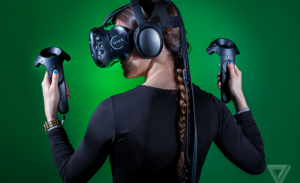The simple act of strapping on a virtual reality headset can transport you from your living room to the middle of an African savannah or into a ship on the bottom of the ocean. This is the promise delivered to us by the virtual reality technology coming from manufacturers such as HTC Vive and Oculus Rift.
Virtual reality technology has come on by leaps and bounds this year but many experts believe the technology is still in its infancy. This is partly because many virtual reality offerings from the past failed miserably. An example of this being Nintendo Virtual Boy, which to be fair, was a far cry from anything being produced today. The virtual reality gadgets of today feature improved graphics, have the ability to track head movement and can produce immersive sound through incorporating state-of-art computer processors in their design. The future of virtual reality seems endless, with enough astounding possible uses to make your head spin.
The physical nature of virtual reality
Virtual reality has the ability to incorporate physical activity into its games or interactions. The HTC Vive features two handheld controllers that allow users to manipulate items in-game, such as swing a baseball bat or draw with a paintbrush. The only drawback in this case is that while the images inside the device may look like you are swinging the baseball bat, your hands still feel like they’re holding a game controller. Luckily, this is one of the easiest areas for the technology to improve and should be one of the first areas to do so. Nelson Gonzalez, cofounder of Alienware feels that “The next evolution of VR would be where you participate physically in the VR world.” This means that instead of swinging a controller, you would swing a real baseball bat, throw a real baseball and so forth. Team games can become interconnected and interfaced meaning all that’s needed is the space to play.
Incorporating touch is only the tip of the sensory iceberg when you consider the very real possibility of including other elements like wind and smells. With today’s offerings we are limited to visual and auditory stimulation but that only covers two of our senses. It would be wise not to forget about our other senses down the road. Temperature sensing is another capability that we would love to see, but let’s not forget about the biggest (but also most difficult) sensory hurdle called gravity. Maybe that’s asking for too much, for now at least.
The industry seems unsure about exactly how sensory technologies will be implemented in the near future but being able to interact in a virtual reality environment without controllers via motion sensing cameras is definitely one of the next steps in the evolutionary path. Users can already buy armbands that enable gestures to be sensed by the Oculus Rift device. The rest is surely just a matter of time.
Everyone is onboard
Broadening the capabilities of virtual reality is an effort the whole industry is a part of. We will see technology companies rallying around VR technology in the same way they did with the computer gaming industry. Companies such as AMD, Intel or Nvidia got on board early and pushed the boundaries by designing more and more powerful chips or graphics processors. The technology will have to be taken forward by a coordinated effort where all applicable technologies work together to provide a working end product and usage landscape. Looking at where virtual reality is in use already gives us a clue as to how widespread the technology already is and how much a part of our daily lives it will one day become. Current innovators are found in the gaming industry, which has embraced the technology from the very beginning (since 1962 in fact), the real estate industry that is using virtual reality to showcase homes to potential buyers off site and vacation providers that offer their customers an advanced sneak peak into their trip. Ticket vendors for sporting events or concerts are also making use of the technology and showing buyers the virtual view from any seat they wish to purchase. Even the porn industry is fully on board and making use of the technology. Online pornography purveyors such as VRSmash have developed the means to display videos in virtual reality and deliver a fully immersive experience.
With the adoption of the technology already being so widespread and so much demand coming from audiences around the globe, it’s easy to see that virtual reality is here to stay. We will undoubtedly see the technology come on by leaps and bounds in the not to distant future and I for one cannot wait.

